Tom's Hardware Verdict
Corsair’s Force MP600 is one of the fastest SSDs on the market, with sequential performance of up to 5,000 MBps. But the speed and slick aesthetics are come at a high price. And many tasks don't benefit from the extra speed.
Pros
- +
Impressive performance
- +
Large write cache
- +
Power-efficient
- +
Effective heatsink
- +
Attractive
Cons
- -
Pricey
Why you can trust Tom's Hardware
Corsair’s latest SSD is one of a swarm of new PCIe 4.0 models designed for AMD's Ryzen X570 platform or the brand-new Threadripper TRX40 boards. With the enhanced bandwidth that the latest bus revision offers, the Corsair Force MP600 can hit performance figures that other NVMe SSDs envy, up to 5 / 4.25 GBps read / write. But will that extra bandwidth really help your day-to-day workflow?
AMD’s latest X570 / Ryzen 3000 platform incorporates PCIe 4.0 into its design. Besting out Intel on this front, with very competitive pricing (especially on the CPU side) has led to impressive uptake for AMD's latest mainstream platform. With so much bandwidth at your disposal, 2GBps per lane, this opens the door for many high-bandwidth devices, including SSDs.
To match up with AMDs momentum, Phison undertook the task to develop a PCIe 4.0 NVMe SSD controller to launch some enthusiast-class storage to go alongside AMD’s new hardware, the E16. But, in order to keep pace with the launch of Ryzen 3000, Phison first opted to adapt their E12 controller to utilizes the 4.0 interface. Corsair and other drive makers in the initial launch of PCIe 4.0 SSDs add in Kioxia’s (formerly Toshiba Memory) latest BiCS4 96L TLC flash and a newer, fourth-generation Low-Density Parity Check (LDPC) error correction algorithm among other minor firmware tweaks. So in some ways, these new SSDs are like their E12 counterparts, just with much higher sequential bandwidth.
| Product | Force MP600 500GB | Force MP600 1TB | Force MP600 2TB |
|---|---|---|---|
| Pricing | $129.99 | $189.99 | $374.99 |
| Capacity (User / Raw) | 500 / 512 | 1000GB / 1024GB | 2000GB / 2048GB |
| Form Factor | M.2 2280 | M.2 2280 | M.2 2280 |
| Interface / Protocol | PCIe 4.0 x4 / NVMe 1.3 | PCIe 4.0 x4 / NVMe 1.3 | PCIe 4.0 x4 / NVMe 1.3 |
| Controller | Phison PS5016-E16 | Phison PS5016-E16 | Phison PS5016-E16 |
| DRAM | DDR4 | DDR4 | DDR4 |
| Memory | Toshiba 96L TLC | Toshiba 96L TLC | Toshiba 96L TLC |
| Sequential Read | 4,950 MBps | 4,950 MBps | 4,950 MBps |
| Sequential Write | 2,500 MBps | 4,250 MBps | 4,250 MBps |
| Random Read | 420,000 IOPS | 680,000 IOPS | 680,000 IOPS |
| Random Write | 550,000 IOPS | 600,000 IOPS | 600,000 IOPS |
| Encryption | AES 256-bit Encryption | AES 256-bit Encryption | AES 256-bit Encryption |
| Endurance | 850 TBW | 1,800 TBW | 3,600 TBW |
| Part Number | CSSD-F500GBMP600 | CSSD-F1000GBMP600 | CSSD-F2000GBMP600 |
| Warranty | 5-Years | 5-Years | 5-Years |
Corsair lists the Force MP600 in three capacities: 500GB, 1TB, and 2TB. Launch pricing came in at a significant premium, higher than what the Samsung 970 EVO Plus was going for at the time. But now, pricing actually undercuts the PCIe 3.0 Samsung drive, making the MP600 quite a value for those looking for one of the fastest SSDs available. The 500GB model is $125, 1TB is $185, and the 2TB model is a whopping $370.
On the spec sheet, the Corsair Force MP600 is rated for up to 4,950 / 4,250 MBps, and capable of dishing out 680,000 / 600,000 random read/write IOPS. Write performance is also sped up by a dynamic write cache that spans one third the free space, so up to 333GB on an empty 1TB drive. The drive's endurance is also high. The 500GB model can handle up to 850TB of writes, the 1TB model up to 1,800TB, and the 2TB model is rated for up to 3,600TB written.
Unlike most SSDs, Corsair’s Force MP600 also features hardware-accelerated AES 256-bit encryption support to keep your data safe from prying eyes. As well, it comes with the standard support for TRIM, S.M.A.R.T. data reporting, and secure erase via the Format NVM command.
Software and Accessories
Corsair supports SSDs by providing an SSD Toolbox for download. With it, you can monitor your drive’s health, overprovisioning, and even clone your data over to the new drive.
Get Tom's Hardware's best news and in-depth reviews, straight to your inbox.
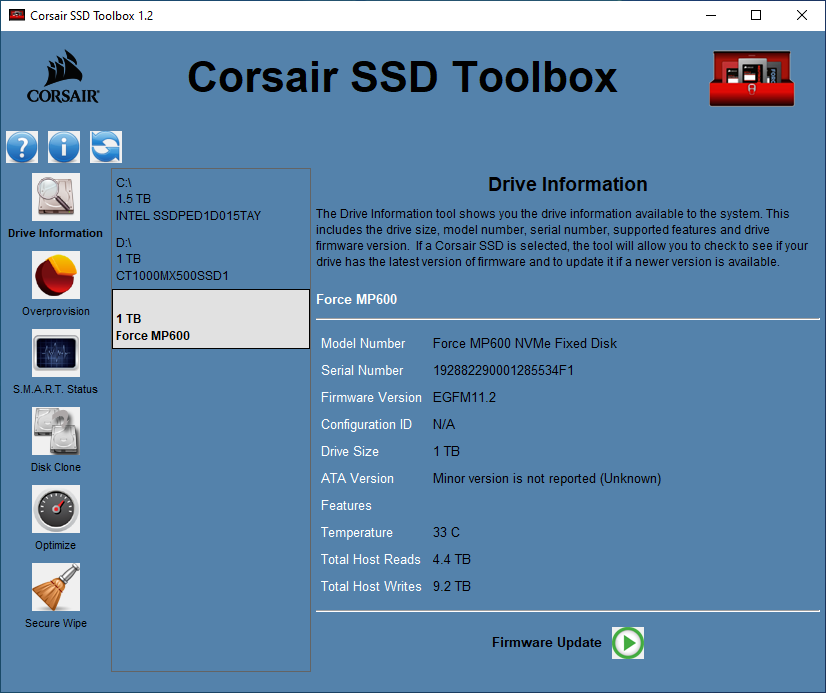
There is a secure wipe feature, but instead of sending the Format NVM command for a secure erase, the tool writes to the whole capacity of the drive, wearing it out and not guaranteeing data is fully wiped. We suggest if you are going to try to secure erase it, that you do so by sending the proper commands instead by either using your motherboard’s built-in tool or supporting software like Parted Magic.
A Closer Look
The Corsair Force MP600 1TB is an M.2 2280 form factor SSD with a massive heatsink. The hunk of black metal isn't the biggest we’ve seen, but at 15mm thick, you'll want to install it in an open space on your motherboard rather than under the GPU. The heatsink is at least removable, so you can use the SSD with your motherboards built-in heatsink instead.


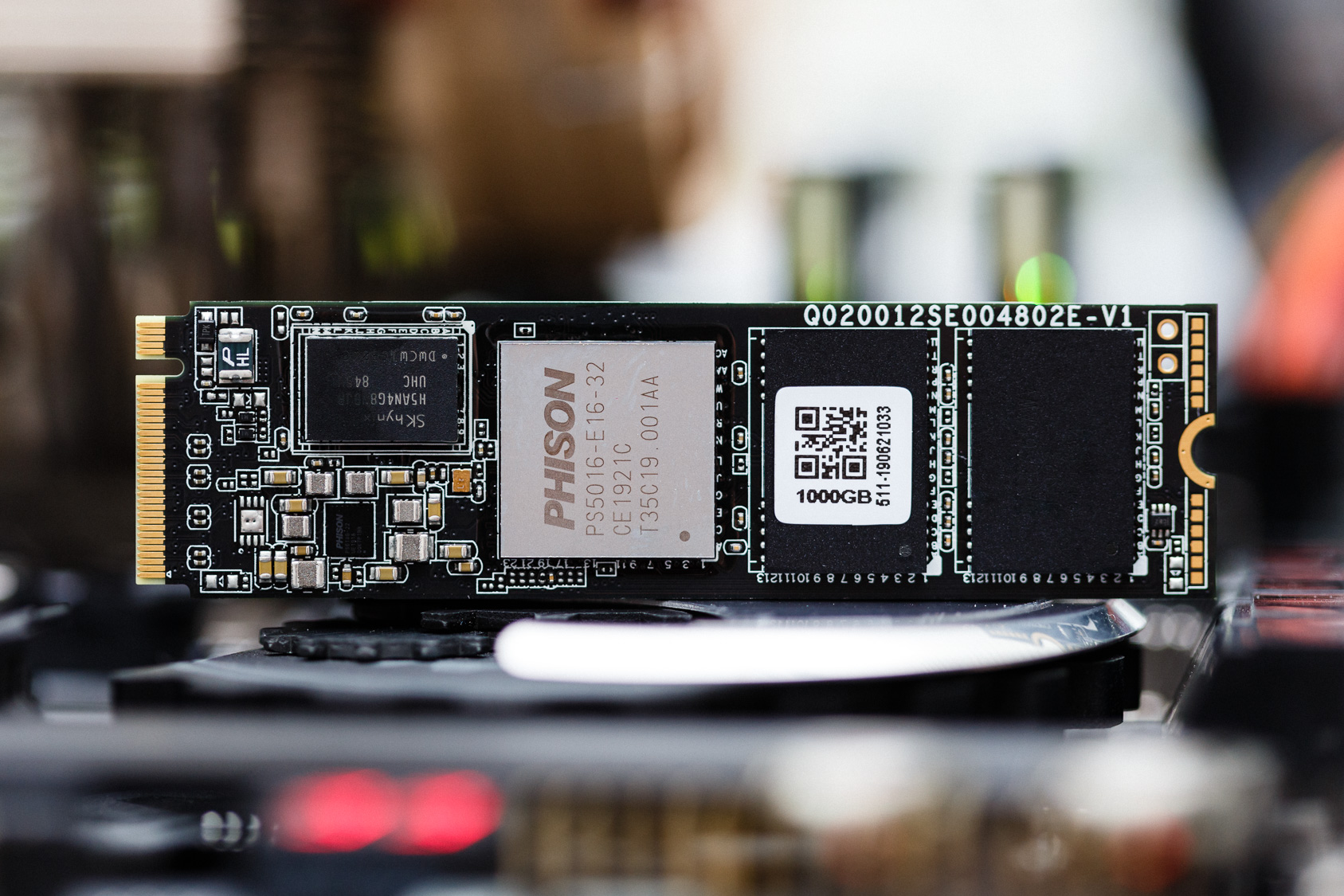
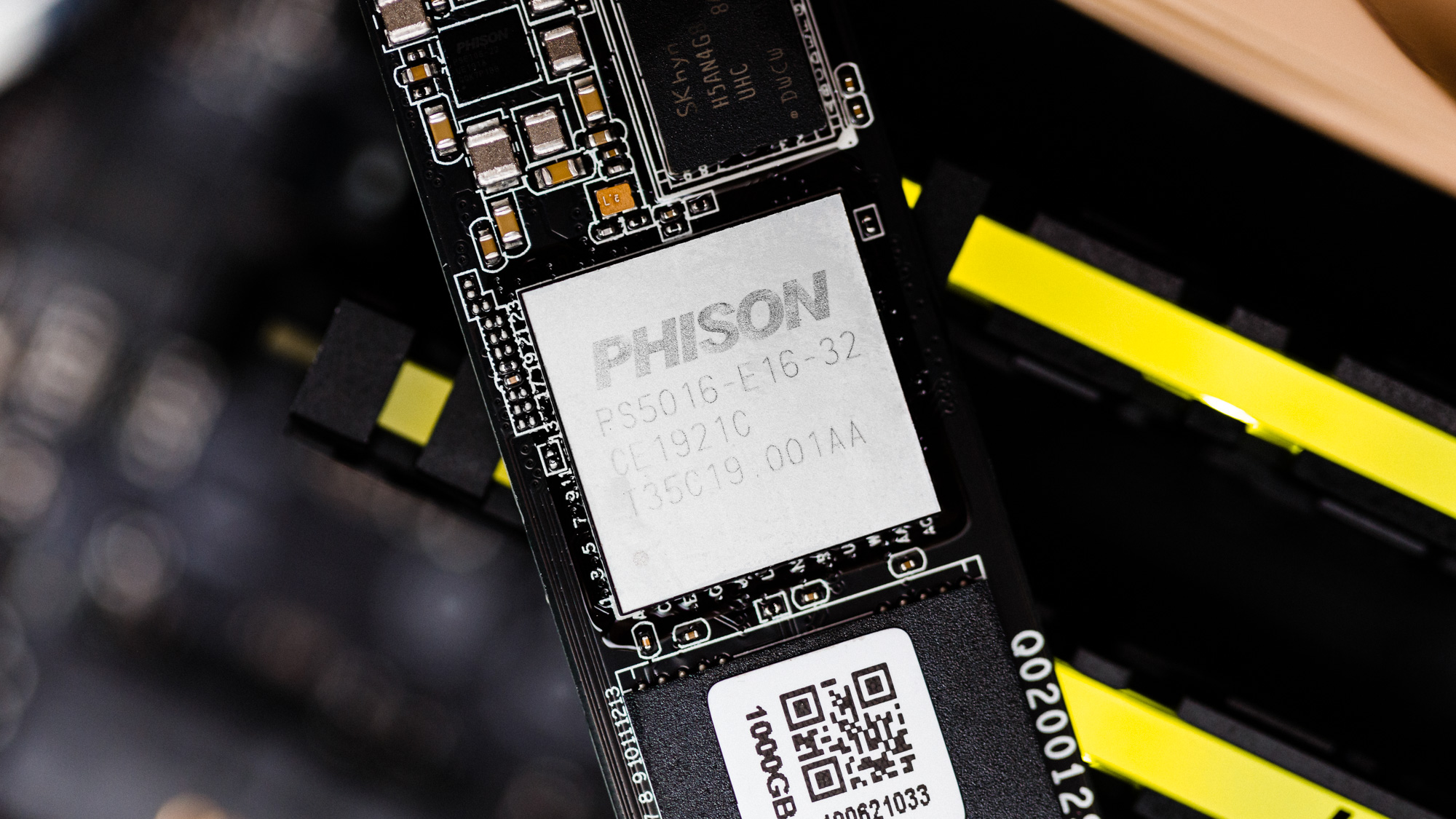


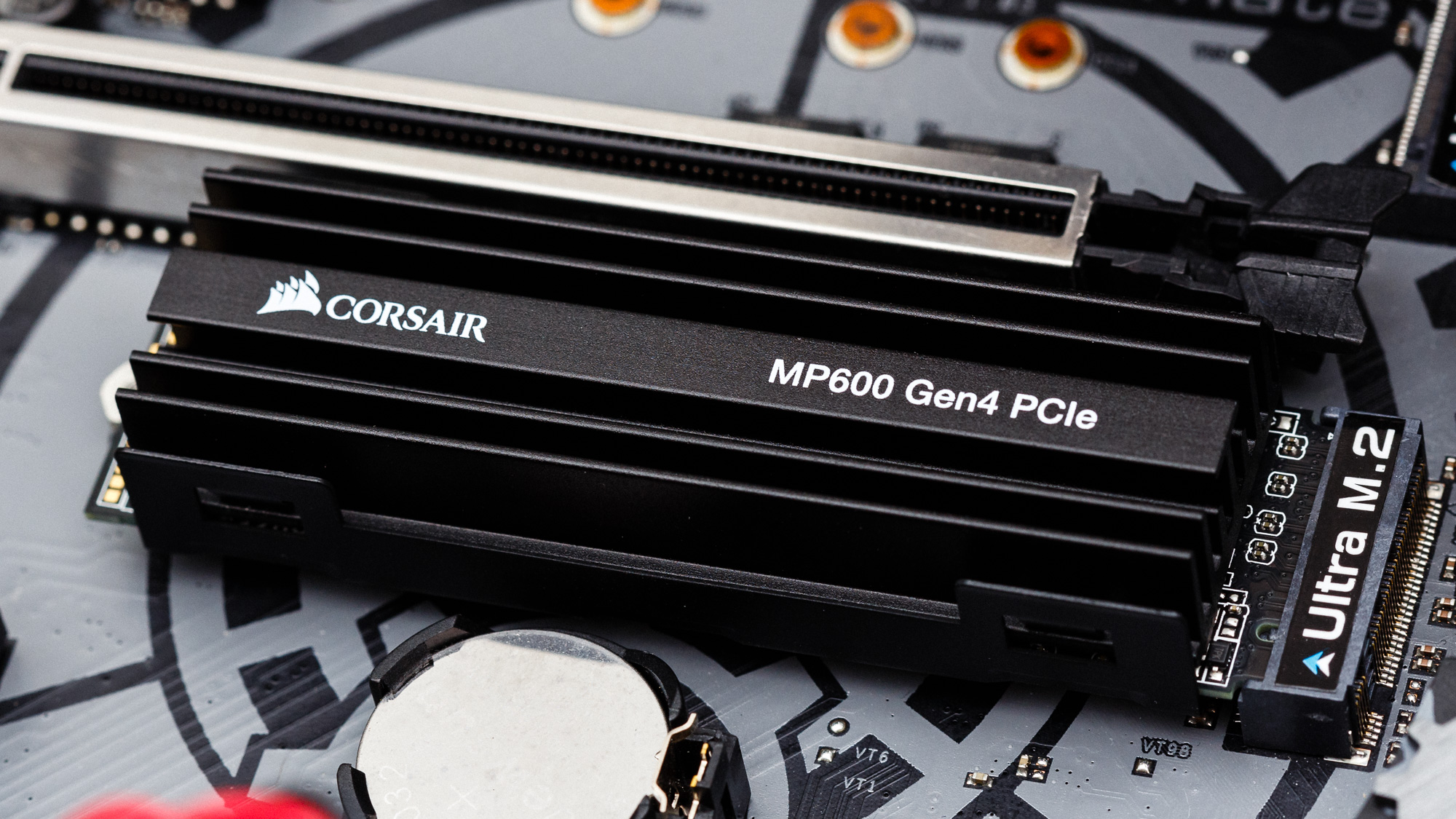
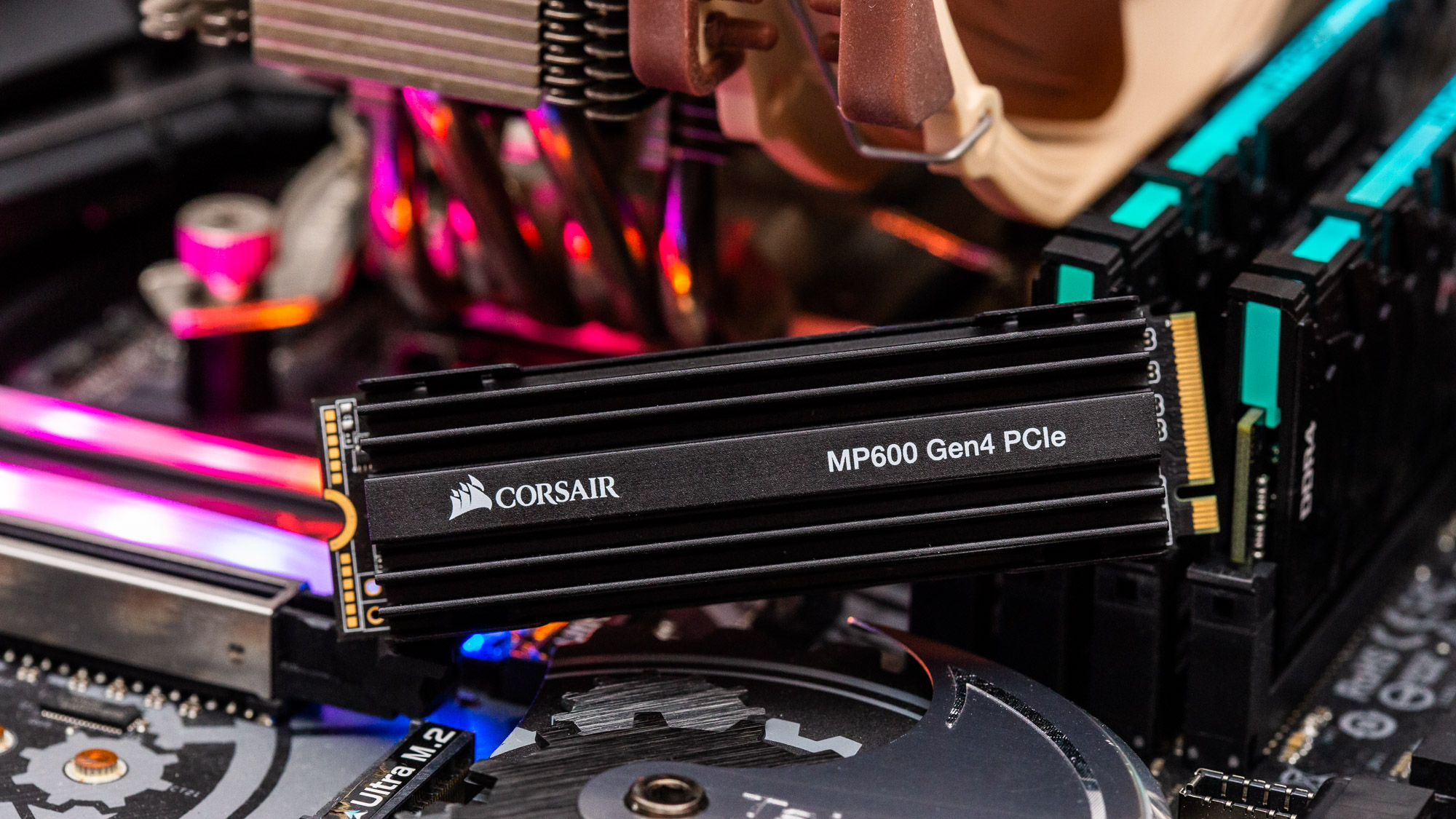
Powering the MP600 is Phison’s E16 PCIe 4.0 x4 NVMe controller, paired with Kioxia’s BiCS4 96L TLC flash. Together this combo provides sequential performance that can’t be topped -- at least for now. In total, there are four NAND emplacements on our 1TB sample, two on each side of the PCB. There are also two DDR4 DRAM ICs, one on each side as well, that aid the controller as a cache for the file mapping table.
MORE: Best SSDs
MORE: How We Test HDDs And SSDs
MORE: All SSD Content

Sean is a Contributing Editor at Tom’s Hardware US, covering storage hardware.
-
dan_L I'm kind of wondering why the article didn't include the most comparable NVMe drive, the Gigabyte Aorus? It would seem to make sense to see how the two compare.Reply
I got the 1 TB Aorus a few weeks ago and it does, indeed, top 5,000 MBps sequential reads and close to 5,000 for sequential writes (using CrystalMark). I can report that this speed definitely makes one's computer a lot peppier than, say, the Samsung 970 EVO it replaced, espepcially when doing intensive desktop publishing and copying files of just about any size. The price of the Aorus does come down to $210 at Micro Center and newegg.com from time to time. -
seanwebster Reply
I do not have access to one. Besides, its the same exact drive with a different heatsink. The performance is the same.dan_L said:I'm kind of wondering why the article didn't include the most comparable NVMe drive, the Gigabyte Aorus? It would seem to make sense to see how the two compare.
I got the 1 TB Aorus a few weeks ago and it does, indeed, top 5,000 MBps sequential reads and close to 5,000 for sequential writes (using CrystalMark). I can report that this speed definitely makes one's computer a lot peppier than, say, the Samsung 970 EVO it replaced, espepcially when doing intensive desktop publishing and copying files of just about any size. The price of the Aorus does come down to $210 at Micro Center and newegg.com from time to time. -
mrnelson Since we’re all so interested in NVMe speeds with Ryzen 3000, could you publish a few benchmarks with these drives running in a dual RAID 0 configuration? I‘m really curious how AMD’s implementation performs as I’m only familiar with Intel’s RST (this is in light of so many X570 motherboards having at least two M.2 slots).Reply
Given the disparate pricing/sizing/performance of available NVMe drives, there may be low price performance sweet spots going two smaller/cheaper drives in RAID 0, no? -
supremelaw Is Intel planning to make Optane drives that also use PCIe 4.0 bandwidth?Reply
I like the idea of "syncing" chipset speeds with drive interface speeds.
Storage manufacturers should be embracing PCIe 4.0 with more options.
And, NVMe should support all modern RAID modes, in the same way
that integrated SATA ports eventually came with "native" RAID support.
EDIT: just saw this review:
https://www.tomshardware.com/news/lexars-new-nvme-ssd-hits-7gbps-the-fastest-yet-for-a-pcie-40-ssd -
pdegan2814 I ended up getting one of these drives for my most recent PC build, a Ryzen 3xxx system. The performance is definitely there but what sold me was the endurance rating. Honestly, a simple SATA ssd is probably "enough" performance for my needs, what I want is a drive that'll last.Reply